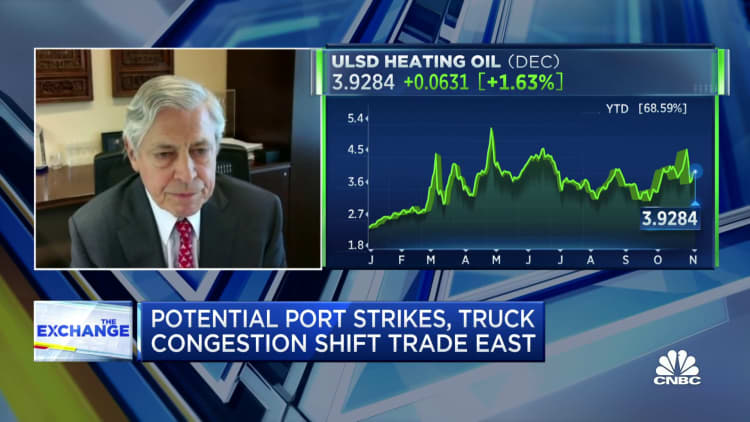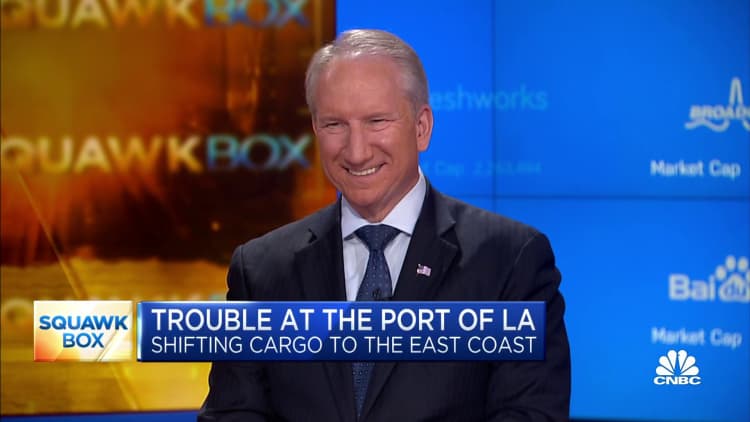[ad_1]
A container crane stands idle at the Port of Los Angeles amid a cargo slowdown on November 16, 2022 in Los Angeles, California. The country’s busiest container port complex, the ports of Los Angeles and neighboring Long Beach, saw imports of shipping containers drop 26 percent in October compared with the same month in 2021.
Mario Tama | Getty Images News | Getty Images
The official container count may not be out, but the Port Authority of New York and New Jersey tells CNBC it will be the No. 1 port moving the most containers in the U.S. for the fourth month in a row.
Unresolved port labor negotiations and the AB5 trucking law — which concerns the employment status of drivers — have migrated trade away from the West Coast to the East Coast and Gulf ports, cementing what seems to be with each month a more likely permanent shift, and benefitting not only the ports but East Coast warehousing as well as the two large railroads that service the ports, CSX and Norfolk Southern. According to ITS Logistics which monitors rail cargo trends, the volume of freight moving out of the East Coast doubles that of the West Coast.
“The port is working extremely hard on making it the most attractive port for ocean carriers and cargo shippers,” Richard Cotton, the executive director of the Port Authority of New York and New Jersey, told CNBC.
There are a variety of reasons why trade is being diverted, but Cotton said the message that shippers and cargo carriers are sending is also about diversification. “They don’t want to have all their eggs in one basket so what we see happening in terms of the decline of other ports, is that much of it has come to the Port of New York and New Jersey,” he said.
“The Atlantic Ocean region volumes are high once again, as shippers continue to avoid the West Coast due to the uncertainty of the IWLU contract negotiations,” said Paul Brashier, vice president, drayage and intermodal at ITS Logistics.
The International Longshore and Warehouse Union and Pacific Maritime Association (which represents the terminals and ocean carriers) have been engaged in a labor dispute for much of this year.
New York first topped California in cargo volume in August.
While volume remains low on the West Coast, the elevated ocean dray on the East Coast started back in January, “when all of the smoke around IWLU started,” Brashier said. “And honestly, we can’t see these trends changing in 2023 until there’s a resolution on that contract,” he added.
East Coast ports making major investments
East Coast ports like Georgia, Virginia and Maryland have been increasing their investment to accommodate the increase in rail capacity. The Port of Virginia is currently deciding if it will open a second inland port. This long-term infrastructure investment is attracting ocean carriers like MSC that has announced plans to build new terminals at the ports of New Orleans and Baltimore.
“What is attracting the trade is the long-term investments the East Coast and Gulf ports are making to meet today’s trade demands,” said William Doyle, executive director for the Maryland Port Administration “Our mix of public-private partnerships have resulted in the investments of the Howard Street Tunnel, investments at our Seagirt Marine container terminal and Dundalk Marine Terminal (berths and on dock warehousing), and dredging. This is just the beginning.”
Private sector investment and state funding have also fueled port investment in Georgia. The Mason Mega Rail Terminal is a $220 million project for the Georgia Ports Authority. At 85 acres and 18 working tracks, the rail yard is now the largest of its kind for a port terminal in North America.
“The expanded infrastructure doubles the Port of Savannah’s previous rail capacity to 2 million twenty-foot equivalent container units per year, and allows Georgia Ports to better serve major inland markets such as Atlanta, Birmingham, Chicago, Memphis, Dallas, and New Orleans,” said a Georgia Ports Authority spokesperson.
The Port Authority of Virginia tells CNBC it does not see any lull in future investments.
“We move more than one-third of our total cargo volume by rail and with our investments, we believe we can push that number to somewhere near 40 percent,” said Stephen Edwards, CEO and executive director of the Virginia Port Authority. “We’re creating a superior rail operation – on-dock, double-stack and served by both of the East’s Class I carriers — that reaches deep into many of the Midwest’s traditional manufacturing and population centers.”
Edwards added they are also adding landside capacity and capability, channel depth, and see more private investment in Virginia by port users – logistics companies, warehouses, distribution centers, manufacturing, etc. Total investments in their rails, terminals, and widening and deepening of Norfolk Harbor is $1.4 billion.

Cotton also was confident that New York’s gains will be lasting, especially after five years of investments.
“If you compare today’s performance to prior years, it has absolutely stayed at an extraordinary level above the prior years. We are not seeing the decline the other ports are seeing,” he said. “The port will continue to set records for the rest of the year and we think that trend will continue. There may be seasonal declines, but the port is hitting on all cylinders.”
CSX, Norfolk Southern rail expansion
CSX said it cannot provide container volumes since the ports maintain and publish the data, but it is seeing growth in the movement of containers.
“CSX continues to see the East Coast ports as a growth opportunity as volumes shift from congested West coast gateways,” said Cindy Schild, CSX spokesperson.
Broad assets are underway, she said, to expand all aspects of port container handling capacity across the Eastern seaboard (e.g., on-dock rail capacity increases, inland port investments, new marine terminals, and terminal expansions, dredging, as well as near dock transload facilities.)
“All of these developments will benefit CSX. There is a high degree of correlation between port TEU throughput and our intermodal, as well as carload, rail volumes,” Schild said, adding that interest from port authorities and other stakeholders in inland port container initiatives are also on the rise.
The creation of inland ports can enable rails including CSX to connect to global markets otherwise served by trucks.
“The development of inland ports has an added benefit for port authorities and communities by alleviating congestion and reducing emissions from truck traffic at port, as well as efficiently increasing overall port throughput capacity,” Schild said.
Norfolk Southern told CNBC it is primed to take advantage of this trade shift.
“Strategic corridor investments and the opening of a dozen new intermodal facilities since 2014 have created the capacity and productivity to support volume growth on our network,” said Ed Elkins, executive vice president & chief marketing officer. “As the global economy becomes even more reliant on the East Coast for supply chain needs, we see a great possibility for smart, sustainable growth.”
West Coast port decline

Cargo volumes on the West Coast remained soft at the Port of Los Angeles in November, which saw a 21% decrease year over year in volumes. Overall, the port moved 7% less cargo in the first 11 months of 2022 compared to last year, which was an all-time record.
“Imports into the United States have begun to level off, in addition to cargo that has shifted away from West Coast ports due to protracted labor negotiations,” said Port of Los Angeles Executive Director Gene Seroka during a media briefing on Thursday. “In the months ahead, we’re going to have to work harder and smarter to earn cargo back. Every ship, every train, every truck needs to be handled with the top-level service our customers expect and deserve.”
The trend of trade continuing to move to the Port of New York and New Jersey over Los Angeles can be tracked in FreightWaves SONAR charts, which shows the incoming vessel capacity.
The Port of Long Beach processed 588,742 twenty-foot equivalent units (TEUs) last month, down 21% from November 2021. Imports slid 28.4% to 259,442 TEUs. Exports increased 13.8% to 124,988 TEUs.
“While some import volume has shifted to other gateways, we are confident that a good portion of it will return to the San Pedro Bay,” said Port of Long Beach Executive Director Mario Cordero. “As we move toward normalization of the supply chain, it’s time to refocus our efforts on engaging in sustainable and transformative operations that will secure our place as a leader in transpacific trade.”
During the first 11 months of 2022, the Port of Long Beach has moved 8,589,553 TEUs, down just 0.5% from 2021, which was the port’s strongest year on record.
While the East Coast gains are significant, there was a “leveling” off of imports detected on the East Coast in November, according to port TEU data from the CNBC Supply Chain Heat Map.
The CNBC Supply Chain Heat Map data providers are artificial intelligence and predictive analytics company Everstream Analytics; global freight booking platform Freightos, creator of the Freightos Baltic Dry Index; logistics provider OL USA; supply chain intelligence platform FreightWaves; supply chain platform Blume Global; third-party logistics provider Orient Star Group; global maritime analytics provider MarineTraffic; maritime visibility data company Project44; maritime transport data company MDS Transmodal UK; ocean and air freight rate benchmarking and market analytics platform Xeneta; leading provider of research and analysis Sea-Intelligence ApS; Crane Worldwide Logistics; DHL Global Forwarding; freight logistics provider Seko Logistics; Planet, provider of global, daily satellite imagery and geospatial solutions, and ITS Logistics provides port and rail drayage services in 22 coastal ports and 30 rail ramps throughout North America.
[ad_2]
